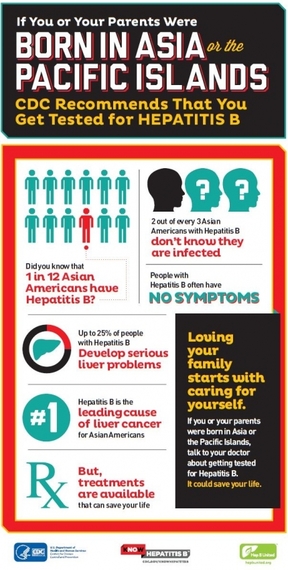Ed. note: A version of this blog was originally posted on the White House Blog.

As part of CDC and Hep B United's Know Hepatitis B campaign, this infographic provides information in a visual and easy-to-understand format.
As May is both Asian American and Pacific Islander (AAPI) Heritage Month and Hepatitis Awareness Month, we are reminded of the staggering impact of Hepatitis B in the AAPI community. AAPIs comprise approximately five percent of the U.S. population, but account for more than half of Americans with chronic Hepatitis B. In fact, one in 12 AAPIs is living with chronic Hepatitis B.
As a result of unprecedented coordination and collaboration among federal partners brought about by the U.S. Department of Health and Human Services (HHS)'s Action Plan for the Prevention, Care & Treatment of Viral Hepatitis, which was just updated last month, we can now leverage a number of new tools to support our ongoing awareness efforts. The Plan is the nation's first comprehensive cross-agency effort to combat viral hepatitis. The Action Plan is also a core element in HHS's 2014-2015 agency plan for the White House Initiative on AAPIs - we encourage you to submit feedback on the agency plan by May 31.
To help increase awareness of Hepatitis B, one tool, created by the Centers for Disease Control and Prevention (CDC), in partnership with Hep B United, is the multi-lingual Know Hepatitis B campaign, which works with community organizations across the country to raise awareness among AAPIs about the importance of Hepatitis B testing and vaccination. The campaign includes many resources, including PSAs, posters, fact sheets and infographics, available in English, Chinese, Korean, Vietnamese, Burmese, Hmong, Khmer, and Lao, to help expand the availability of culturally and linguistically appropriate Hepatitis B education and outreach materials. In addition, flyers, newspaper ads, and posters are also available for community partners to tailor for their local populations.
Another tool is the CDC's online hepatitis risk assessment, which we encourage people to share with their loved ones and community members. People should consult with their health care providers about getting tested for hepatitis.
Broader dissemination and use of these tools, as well as tailored outreach to AAPI communities, will hopefully reduce the disproportionate burden of Hepatitis B in the AAPI population. Working together, we can make strides in breaking the silence on this epidemic.